On May 29, 1917, John Fitzgerald Kennedy was born at his childhood home in Brookline, Massachusetts. Born to politician and businessman Joseph Kennedy, Sr and socialite Rose Fitzgerald-Kennedy, he was destined for greatness and succeeded in ensuring his place in the history books for generations to come. In this article we discuss his biography as well as his style.
The Early Years
JFK spent the first ten years of his life in Brookline, attending the Edward Devotion School, the Noble and Greenough Lower School and Dexter School through fourth grade. It wasn’t until 1927 that the Kennedy family established their roots in New York, taking up residence at 5040 Independence Avenue in the Riverdale community of the Bronx. Within the next two years, they would again relocate, this time to 294 Pondfield Road in Bronxville where Kennedy’s parents would sign him up with Scout Troop 2. Continuing their love for Massachusetts, the Kennedy family spent summers at their summer residence in Hyannisport, Massachusetts and winter holidays at their home in Palm Beach, Florida.
By high school, JFK was sent to Connecticut where he studied at private boarding schools including The Choate School in Wallingford where his brother Joe Jr. was an exemplary student and all-star football player. Having to live in his brother’s shadow, John F. Kennedy began to rebel pulling stunts that even included blowing up a toilet with an explosive device. It was after this stunt that JFK formed what he called “the Muckers Club”, a school gang named after the strict headmaster’s commentary when he referred to the hooligans who blew up the toilet as “muckers” who “spit in our sea”.
It wasn’t long before JFKs antics began subsiding as Kennedy was plagued with health problems in 1934 after being hospitalized at New Haven Hospital before being admitted to the Mayo Clinic in Minnesota and diagnosed with a severe form of colitis. Despite his shenanigans, Kennedy graduated from Choate in June of 1935 and was named “most likely to succeed” in the school yearbook.
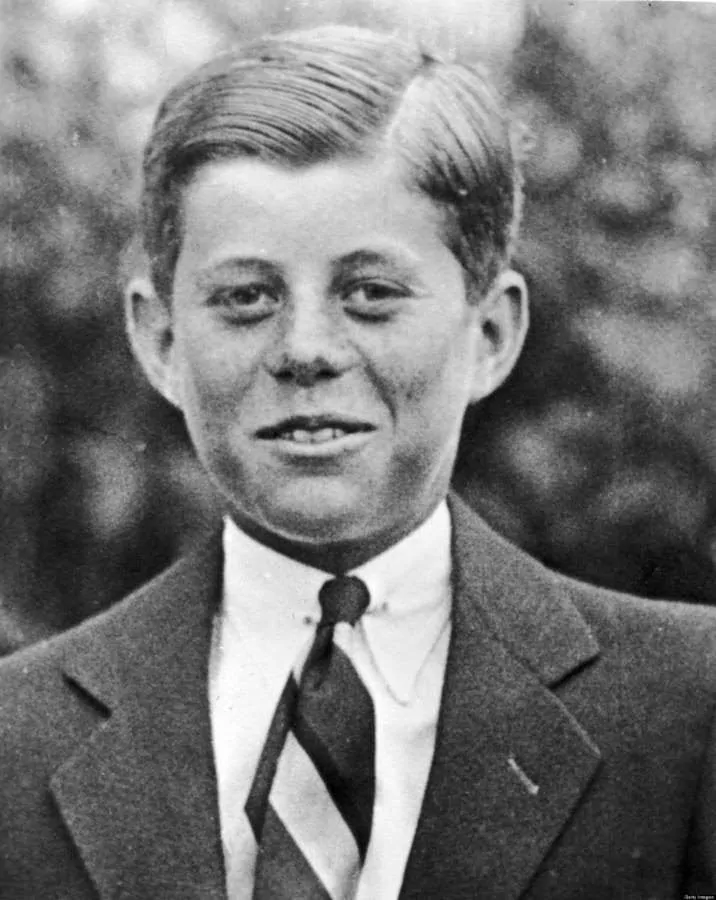
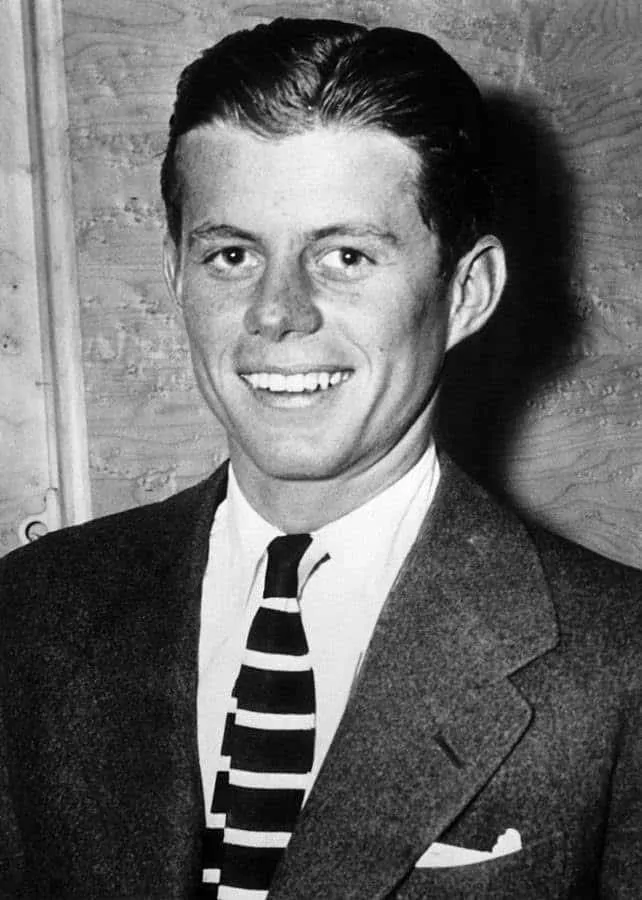
That September, his parents took him and his sister Kathleen to London with the intention of introducing them to Harold Laski of the London School of Economics where the elder Joe Jr. had studied. However, Kennedy’s unfortunate case of colitis re-emerged causing him to return stateside just one month later. Upon his return, he enrolled and spent a little more than a month studying at Princeton University before being hospitalized again in Boston.
After spending much of the spring and early Summer of 1936 working as ranch hands with Joe Jr. in Arizona, he enrolled at Harvard University where he famously created the annual “Freshman Smoker”. Competing on the varsity swimming team, he worked hard and decided in July 1937 to capitalize on his love of the water and set sail to France with a convertible in tow, and spent ten weeks driving through Europe. Then, in June 1938, he set sail again, this time to work with his father, the US Ambassador to the Court of St. James for President Roosevelt at the American Embassy in London.
He spent much of his time touring Europe, the Balkans, the Middle East and the Soviet Union which served as the inspiration for his senior honors thesis at Harvard. On September 3rd, 1939, just two days after Germany invaded Poland, JFK began serving as his father’s representative in an effort to help American survivors on the SS Athenia.
Following his experience working under his father, Kennedy became a more serious scholar and began passionately studying political philosophy. By his junior year, he had reserved his spot on the Dean’s List. His thesis “Appeasement in Munich” became a bestseller under the title “Why England Slept” which documented the British participation in the Munich agreement. In 1940, Kennedy graduated with honors from Harvard College with a Bachelor of Science cum laude in international affairs.
Life in the Trenches
Shortly after joining the Army, Kennedy was given medical disqualification for chronic lower back problems. Not one to give up, he joined the U.S. Navy where he served as an ensign in the office of the secretary of the Navy. Following Pearl Harbor, Kennedy enrolled at the Naval Reserve Officer Training Corps and volunteered for the Motor Torpedo Boat Squadron in Rhode Island. Throughout his naval career, Kennedy commanded numerous boats for his squadron where his was stationed in Panama and later the Pacific theater where he earned the rank of lieutenant.
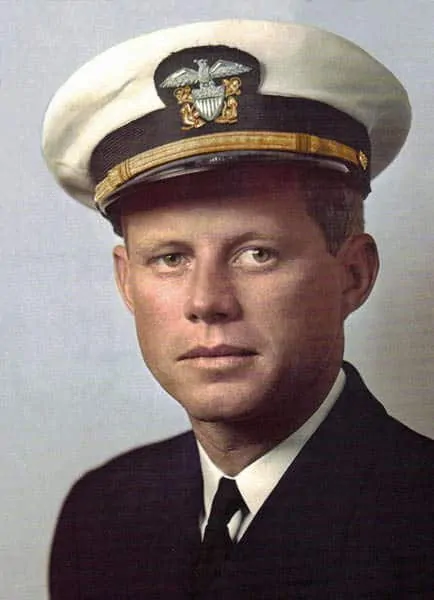
On August 2, 1943, Kennedy’s boat, a PT-109 in addition to two other vessels was patrolling the area of New Georgia in the Solomon Islands when his boat was rammed by the Japanese destroyer Amagiri. Despite a devastating loss to his crew, Kennedy was documented as composing himself quickly and gathering his surviving crew in the water by the wreckage to vote whether to fight or surrender to the destroyer. During his speech, Kennedy stated “There’s nothing in the book about a situation like this. A lot of you men have families and some of you have children. What do you want to do? I have nothing to lose.” After shunning the idea of surrender, the crew swam to a small island to regroup. Kennedy who had severely injured his back in the attack, independently towed a badly burned sailor using a life jacket strap that he clenched between his teeth. For his heroic actions, Kennedy received the Navy and Marine Corps Medal for “extremely heroic conduct as a Commanding Officer of Motor Torpedo Boat 109 following the collision and sinking of that vessel in the Pacific War Theater on August 1–2, 1943. Unmindful of personal danger, Lieutenant Kennedy unhesitatingly braved the difficulties and hazards of darkness to direct rescue operations, swimming many hours to secure aid and food after he had succeeded in getting his crew ashore. His outstanding courage, endurance and leadership contributed to the saving of several lives and were in keeping with the highest traditions of the United States Naval Service.”
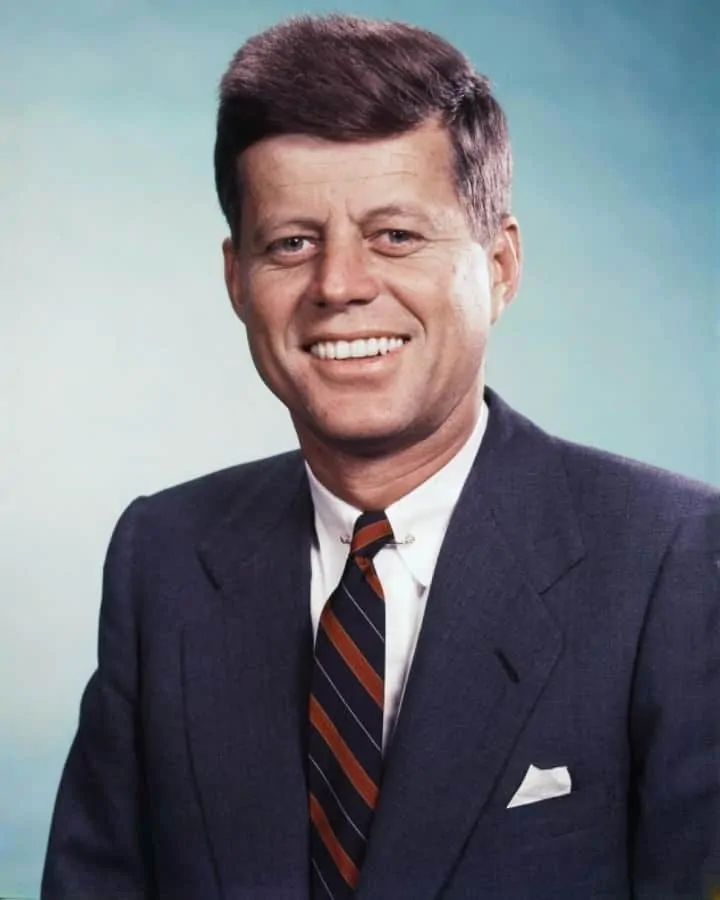
By 1944, after commanding multiple boats in various theaters, Kennedy returned to the United States and following treatment for his injuries incurred in the line of duty, was released from active duty in late 1944.
By the beginning of 1945, Kennedy held temporary residence at Castle Hot Springs resort in Arizona which at the time was serving as a temporary military hospital. In 1945 he received an honorable discharge from the Navy taking with him multiple decorations from his heroic actions in World War II which included the Purple Heart, the American Campaign Medal, the American Defense Service Medal and the Asiatic-Pacific Campaign Medal with three bronze service stars and a WWII Victory Medal.
Following his service to the country, Kennedy’s father, a close friend of William Hearst, brokered a position as a special correspondent for Hearst Newspapers where JFK served as a journalist covering some of the nations largest events.
A Politician is Born
With the untimely death of his brother Joe Jr. in 1944 while serving with the armed forces, John felt that he needed to fill his brothers shoes and carry on his public service life in politics; something that Joe Jr. was well known for.
When U.S. Representative James Michael Curley vacated his seat in the Democratic 11th Congressional district in 1946, Kennedy decided to run for the seat, beating his opponent by a significant margin. In November of 1946, John F. Kennedy took his first position in American politics and served as a congressman for six years.
By 1952, Kennedy had secured his spot as a well liked and heavily respected political figure in Massachusetts. He used this power at the US Senate election where he defeated incumbent Republican Henry Cabot Lodge II for the U.S. Senate seat.
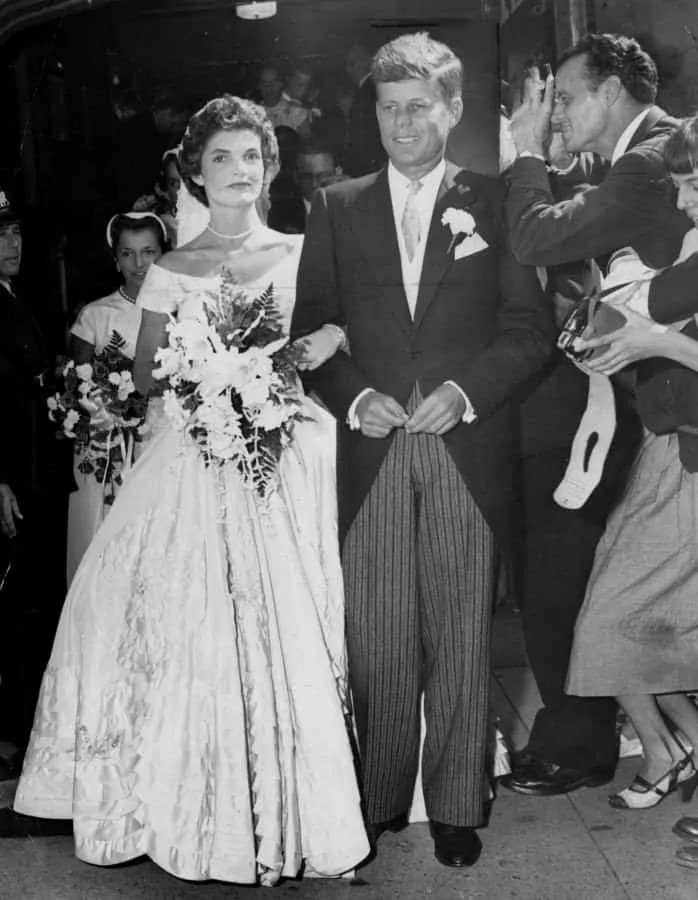
By 1953, Kennedy had met and fallen in love with the alluring and devastatingly charming Jacqueline Bouvier whom he married on September 12 of that year. Over the next two years, Kennedy underwent many spinal operations which left him absent from his seat in the Senate due to being, at various times, critically ill. His medical condition was so bad that at one point he received his Catholic last rites. Nevertheless, he managed to regain strength as well as his health and managed to publish a book under his name with the title “Profiles in Courage” about U.S. Senators who risked their careers for personal beliefs. In 1957, he even won the Pulitzer Prize for that publication however, Herbert S. Parmet investigated thoroughly who actually wrote Profiles in Courage in his book Jack: The Struggle of John F. Kennedy. He concluded that there wasn’t any evidence from reams of hand-written notes and memos that JFK contributed anything substantial to the final version of the book. He might have had a few ideas but it seems more likely that close aide and confidant Ted Sorensen did the majority of research and writing of the book.
Despite his absence from the Senate for much of his term, he was still well liked by the constituents. In 1958, he was re-elected for a second term.
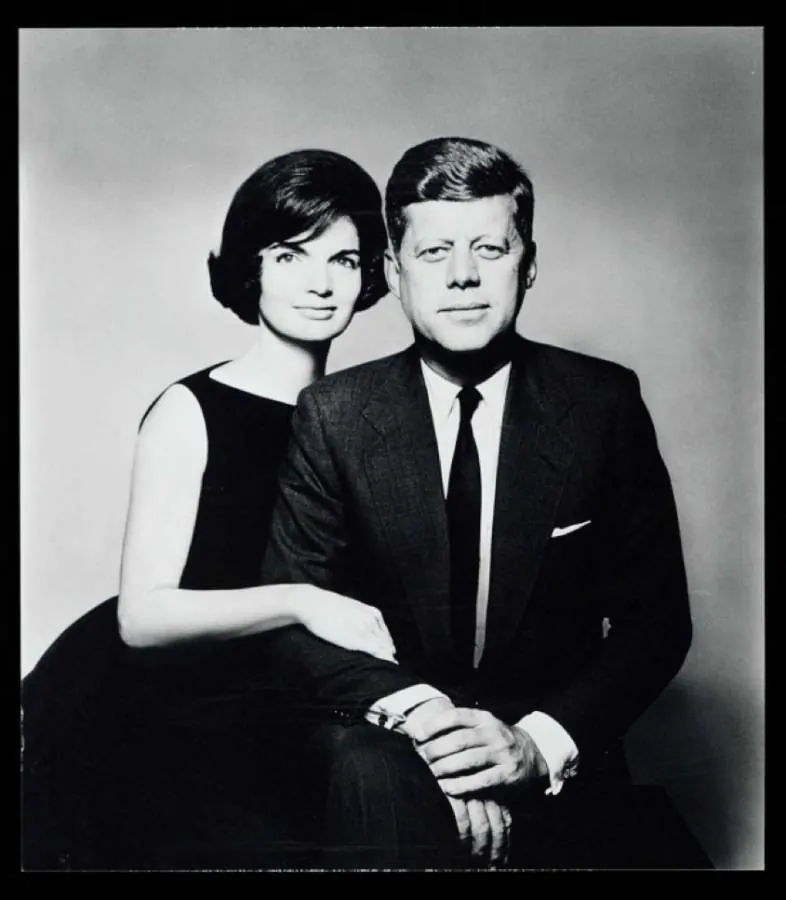
President JFK
On January 2, 1960, John F. Kennedy announced his campaign for presidency in the Democratic primary election. Well liked, young and energetic, Kennedy managed to quickly overrun his competitors using his uniquely cosmopolitan approach to politics. He of course faced certain opposition and a plethora of issues, but managed to do so with both grace and style.
On January 20, 1961, John F. Kennedy was officially sworn in as the 35th President of the United States at precisely 12 o’clock noon. In his inaugural address he famously said “Ask not what your country can do for you; ask what you can do for your country.” JFK was well known for his belief that every American needed to be an active and contributing citizen in order for America to remain a superpower. In his address, he also asked the nations of the world to join together in an effort to fight was he referred to as the “common enemies of man: tyranny, poverty, disease and war”.
His inaugural address was met with critical acclaim as the public believed it showed Kennedy’s confidence that his administration would become historically significant in their fight to ensure America’s continual pursuit of domestic policy and foreign affairs. His management style was polar opposite compared to Eisenhower’s and he preferred the organizational structure of a bicycle wheel where each spoke led directly to the President. He became known for his quick decisions and ability to think on the fly. He was exceptionally confident and optimistic, but had difficulty under the pressure of managing the actual reality of political decisions at both domestically and abroad. Believing that the best cabinet was made up of political veterans and newcomers, he selected an equal mix of experienced and inexperienced individuals to serve under him. He was a tough man to work under, focusing almost exclusively on the immediate issues facing the administration. He has a strong dislike for deeper issues and was known for abruptly cutting off his staff when he felt their commentary was invalid or unnecessary.
With a core focus on economic growth, civil liberties and equality, as well as space policy and the Cuban missile crisis, Kennedy had significant hurdles to overcome in his short tenure as President. While he remained well liked by the masses, the ones who disagreed with his politics really despised him. Many called it a love/hate relationship and the individuals who worked under him either felt very well respected or completely alienated and ignored. Kennedy was as wild a president as he was a youth, focused on what mattered to him. He was tough and quick on the draw, using his military command experience to benefit him in the oval office.
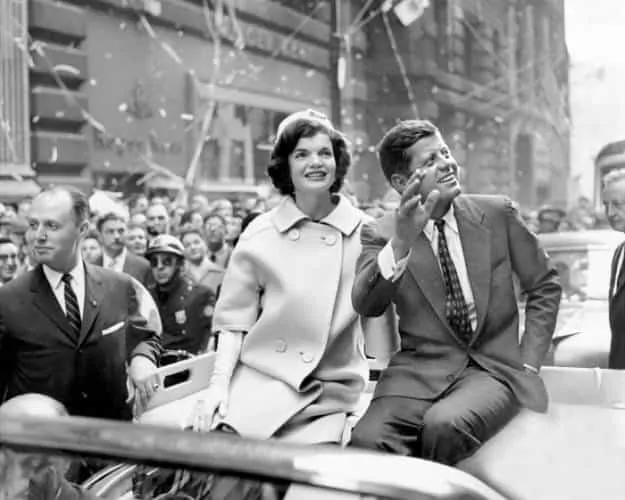
JFK Style: 12 Things of Note
By Sven Raphael Schneider
JFK was the youngest elected president of the U.S. and as such his style was more youthful compared to his predecessors. Some blame him for the decline of men’s hat wearing culture. Before Kennedy, all presidents wore top hats on their Inauguration and although Kennedy brought one, he hardly ever wore it. With his strong charisma and modern appearance, at this time men did indeed stop wearing hats even when they were bald. However, the triumph of the automobile and the decrease of head space compared to buses and public transportation had probably a bigger impact than Kennedy.
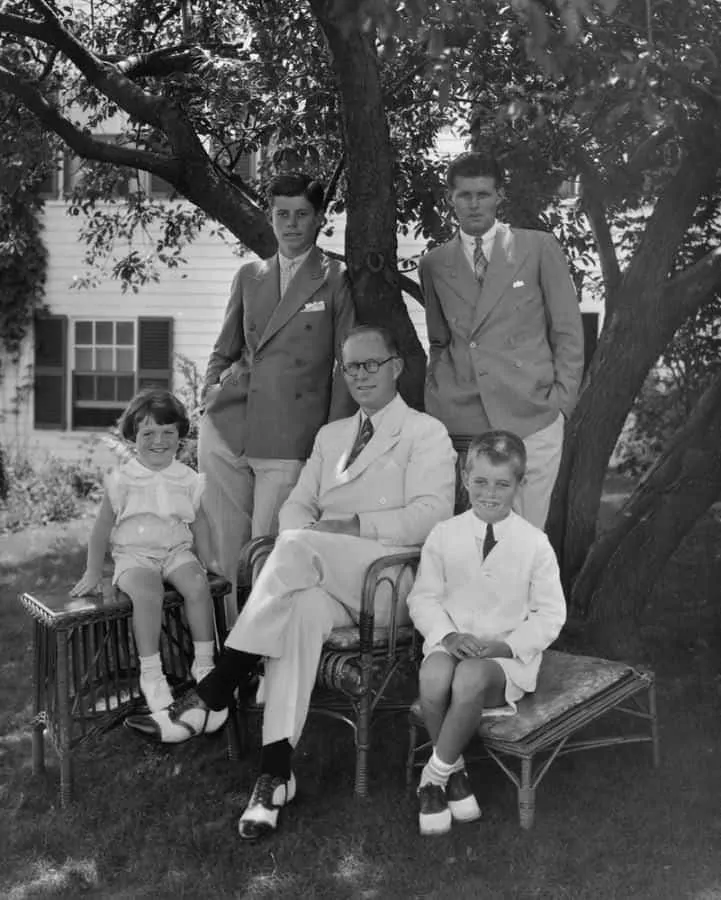
That aside, Kennedy knew how to dress in the office and at home, and his style was influenced by the Ivy League and later on the slimness of the 50’s and 60’s. He wasn’t supremely well dressed, and played it safe most of the time. As a head of state one must look dignified, not necessarily dressed to perfection, otherwise the ordinary man might judge him as aloof. Although he was regarded as a fashion or style icon by the public across the U.S., he sometimes committed a faux-pas like wearing a jacket with broken buttons or pairing short socks with formal suits.
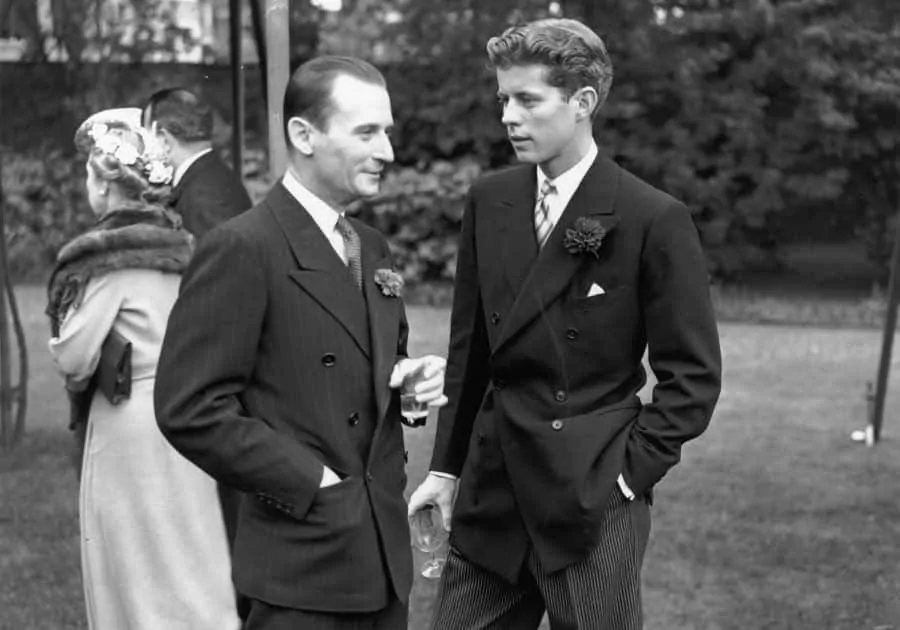
As a teenager, JFK’s style was heavily influenced by the 1930’s. He would wear the typical wide lapels, double breasted combinations, proper shoes, shirts, collar pins and boutonnieres. His suits were a bit more daring, the grey of his suits was lighter and the patterns a bit bolder. His outfits showed more variation than in his later years but by no means were his looks over the top. In fact, the young JFK with reverse chalk stripes, knit ties, boutonnieres, collar pins and double breasted jackets had a more unique style than the older JFK. In the following, I’d like to point out a number of things that JFK was famous for but also provide some inspiration and take-aways in the shape of important things you can learn about JFK’s Style.
The Suits of JFK
When most people think of Kennedy and his suits, they will picture him in a dark blue or grey solid worsted suit with slim notched lapel, white dress shirt, maybe a white pocket square and a slim striped, solid or printed mircopattern tie in subdued colors, but that’s about it. A closer look reveals a few interesting things.
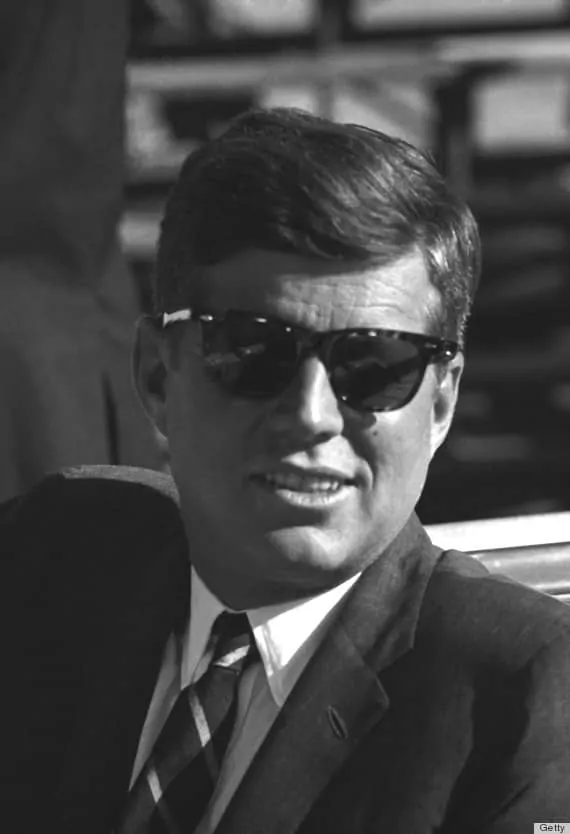
1. JFK was a Brooks Brothers man. For his wedding in 1953 the groomsmen’s gifts were monogrammed umbrellas from Brooks Brothers, and his underwear (light blue cotton boxer shorts in size 34) came from the same house. As such, it doesn’t come as a surprise that most of his suits came from there as well.
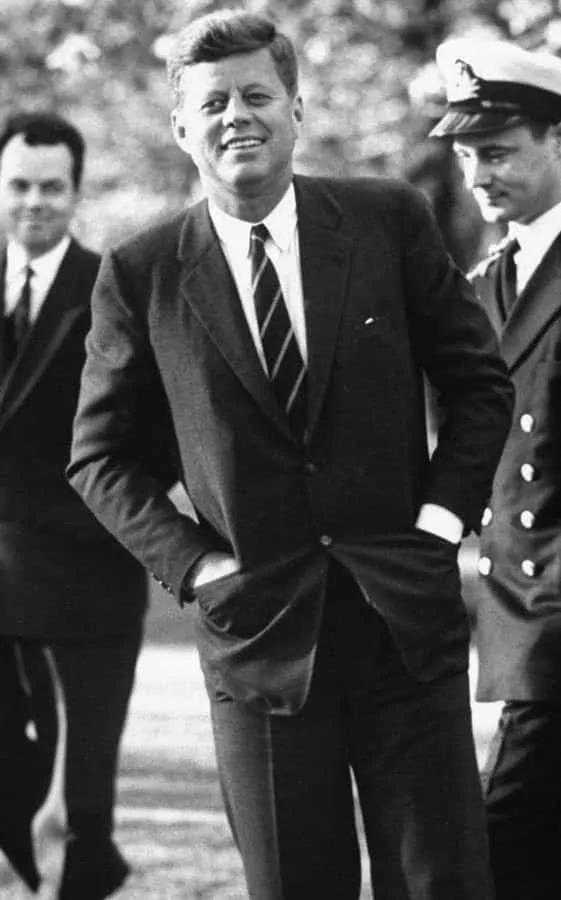
2. At the time, the look was slim, the shoulders had little padding and the jetted or sometimes flapped pockets suited the ventless, single breasted jacket with slim notched lapels. He almost always wore a single breasted coat with 2 buttons, and most of the time he buttoned both of them. Now, most guides declare that a faux pas. However, this kind of blind rule following has nothing to do with elegance. On top of that, it is factually incorrect because Kennedy’s suits were mostly cut like a paddock suit with a slightly elevated closing button, which allowed the bottom button to be buttoned as well. For more details about this cut, click here.
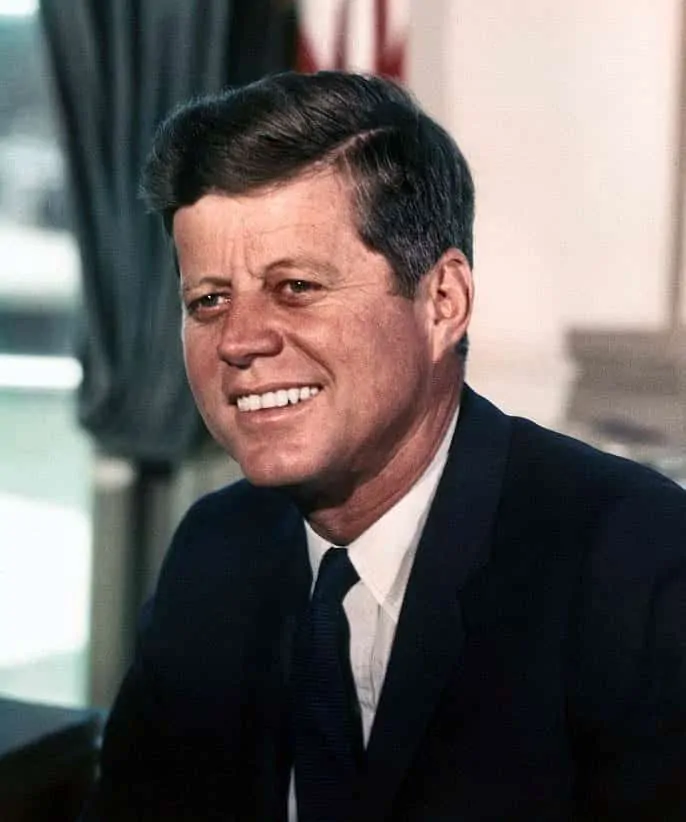
3. During his time in office, he never wore any other suit color than dark blue or grey because he liked to be perceived like a trustworthy statesman. Mostly, he wore solids, pinpoints or the occassional subtle pin stripes but he wasn’t as daring as in his earlier years.
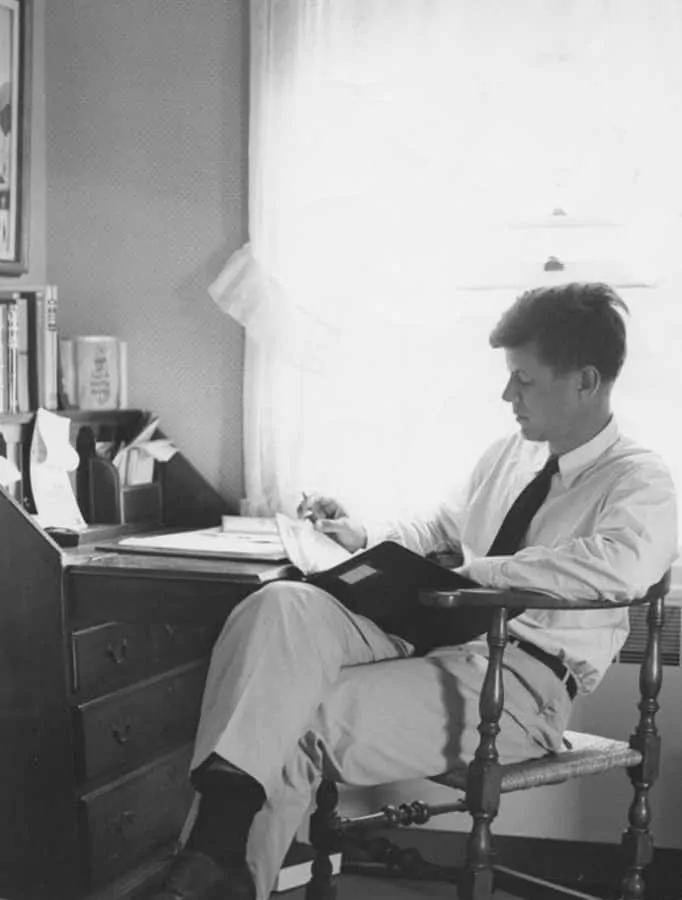
4. His pants were rather slim, without pleats and an ironed crease and cuffs. Sometimes you could also see a plain hem but usually he opted for cuffs or turn-ups, as the British say.
5. His suits came mostly with 4 cuff buttons but sometimes you would also see 2 or 3.
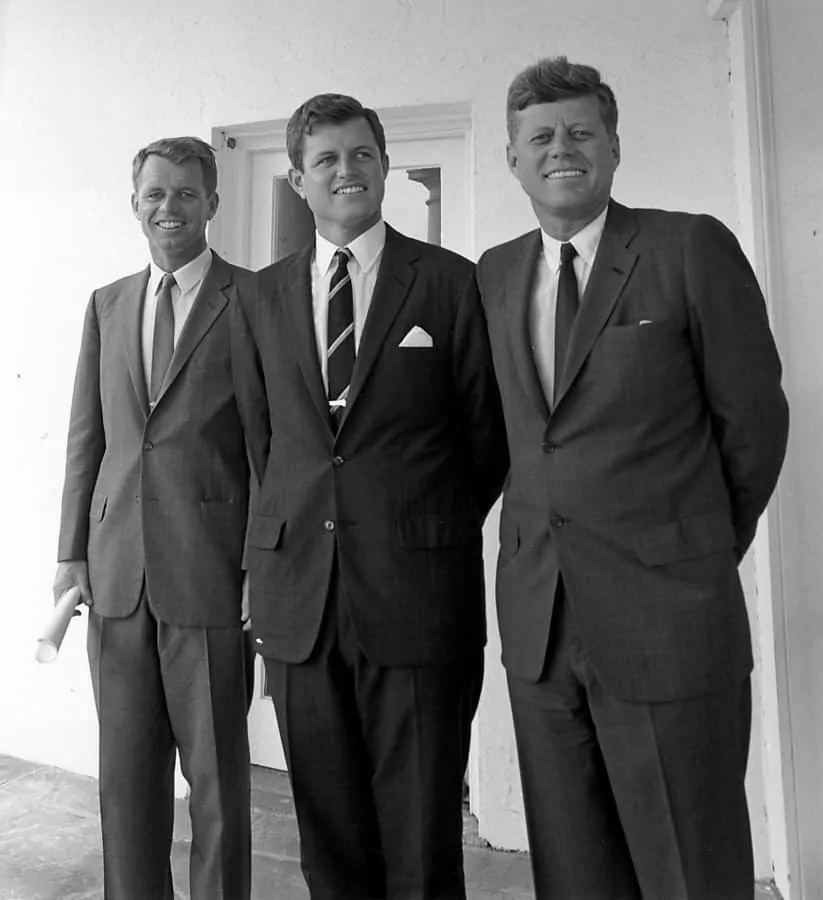
6. His tri-fold pocket squares often disappeared in his pocket so you could only see a sad little white corner. To prevent this issue with your own wardrobe, select a pocket square in the right size relative to the fabric; in this instance, JFK’s was too small. To get his look, check out the white linen pocket square from Fort Belvedere sized so it won’t disappear in your pocket over the course of a day.
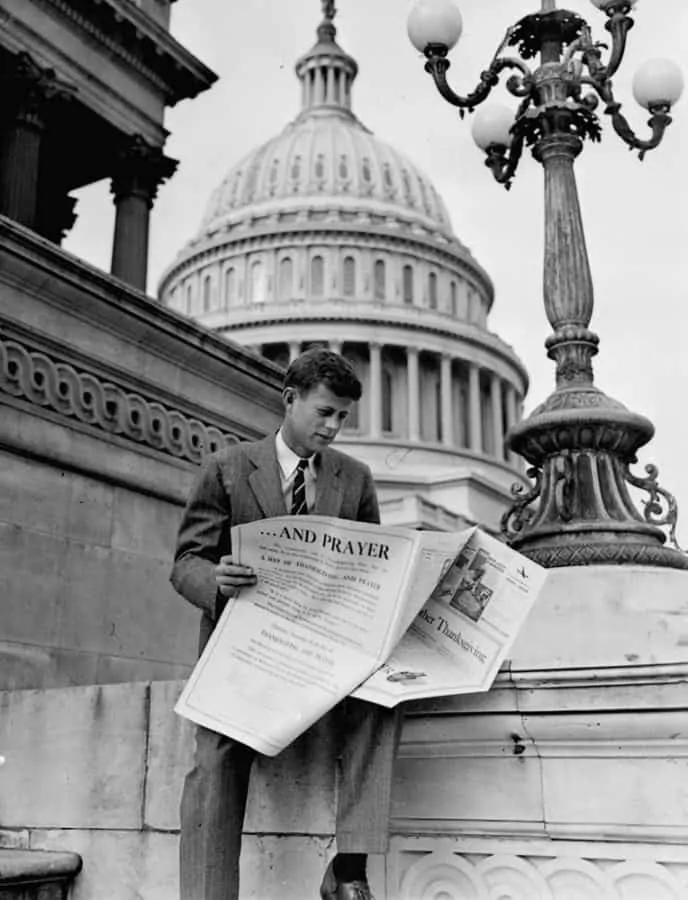
7. JFK’s dress shirts in his later life were almost exclusively solid in white or in some instances light blue or striped. At the time, spread collars were not really popular and so you hardly ever see JFK in a collar other than a classic point. He would wear double cuffs, and sometimes barrel cuffs, yet he rarely showed much cuff under his jacket sleeves. Personally, I prefer to show at least some shirt cuff because it looks more well put together. To learn more about that topic, click here to read our sleeve length guide.
8. With his suits, he would wear black or dark brown captoe oxford shoes and sometime a derby.
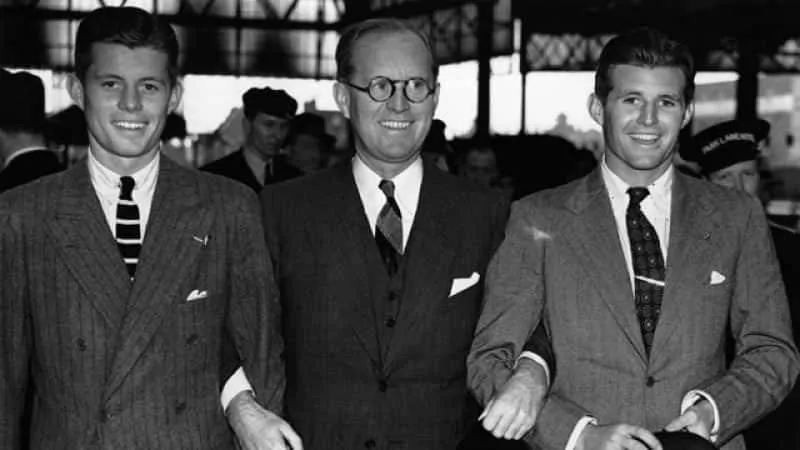
9. While the young JFK would wear a broader range of ties, including wool ties and knit ties, he switched to all silk ties during his presidency. One of his favorite neckwear colors was blue, which he wore in all shades. He often wore stripes in both the American way (right-down-to-left top) as well as the British way (left-down-to-right top) with blue grounds and red, tan, yellow, or a light blue stripes. Alternatively, he wore micropatterns and macclesfields neats; he was wearing a dark blue micropattern tie from Christian Dior on the day he was assassinated. In line with the slim look of the 1960’s his ties were mostly around 7 cm / 2.75″ wide.
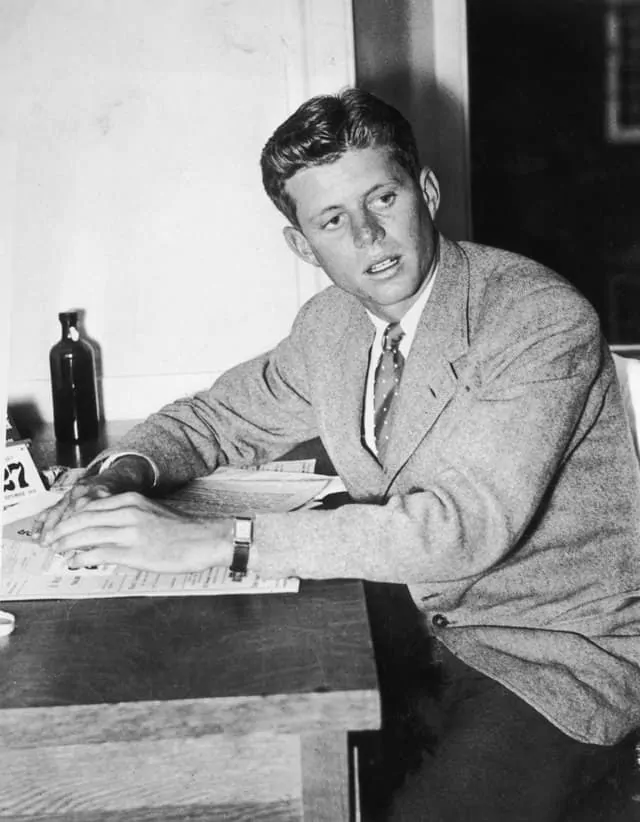


11. One of the accessories JFK really adored were wristwatches. Flat, gold, and rectangular was the style he seemed to favor all his life. As a president, he often wore an Omega Stockdale watch in 18ct yellow gold, which is now part of a collection at the Omega Museum.
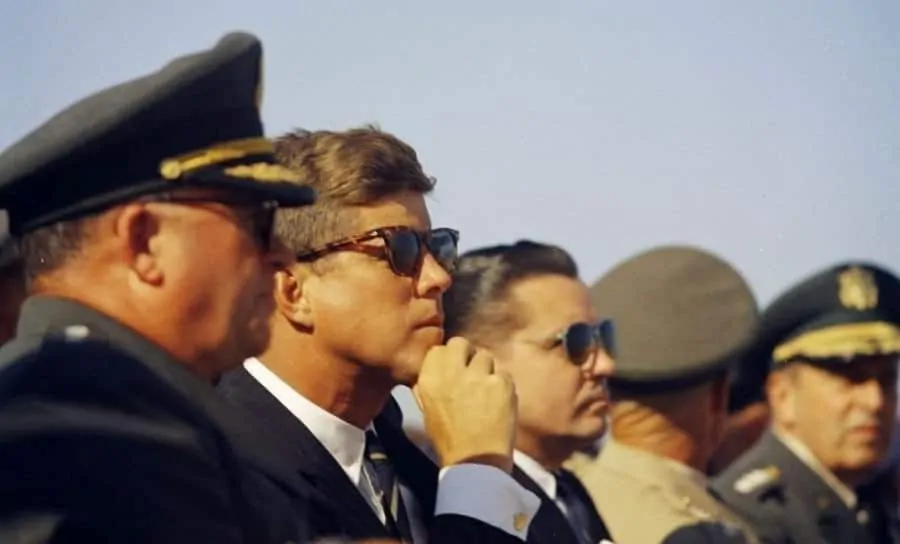
12. The cufflinks he wore were mostly simple gold in round or oval shapes. As president, he often wore 14kt yellow gold cufflinks with the Seal of the President. Interestingly, he used them as gifts to close friends or foreign presidents, prime ministers or diplomats, which is why pairs still pop up for sale every once in a while.
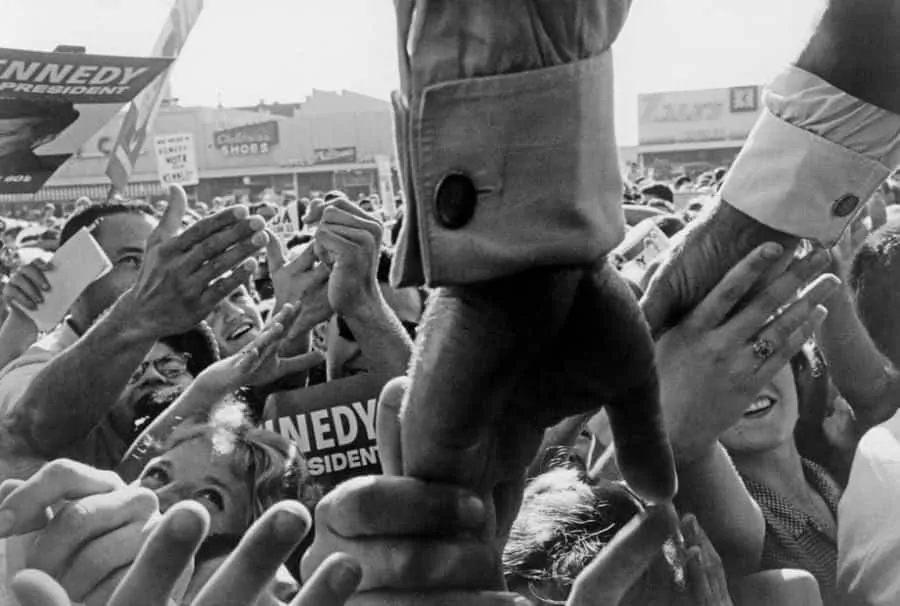
Casual Style
Kennedy loved to relax on his sailboat Victura which was gifted to him as a 15 year-old boy by his father. You’d see him wearing long sleeved and short sleeved polo shirts in blue or mid grey, sometimes also heavier knit sweaters or cardigans in navy or dark colors. When it got really cold he would sometimes dig out a G-1 Flight Jacket which was the Navy’s equivalent of the Army’s Type A-2 flight jacket.
His slacks were mostly khaki cotton twills or off white wool or cotton pants with cuffs and creases. Paired with contrasting socks in vibrant colors such as royal blue, he would wear boat / deck shoes, canvas shoes or (penny)loafers.
When JFK was ashore, you could sometimes see him in a blazer or Harris tweed jacket with the same casual khaki or cream trousers, and classic dress shirts and ties. In my opinion, his style wasn’t overly refined and just good enough to be perceived as well dressed by the general public.
Often, you can read that he wore tortoise shell Ray Ban Wayfarer II sunglasses but upon closer inspection of the pictures, it turns out that this claim is simply untrue. Providence Optical found out that he likely wore three different pairs of tortoise shell sun shades:
1. American Optical TC74-51
2. Cabana TS 2505
3. Universal Optical “Mansfield Square” glasses
That aside, he would also wear also wear aviator sunglasses at times, though I don’t think the shape flattered him.
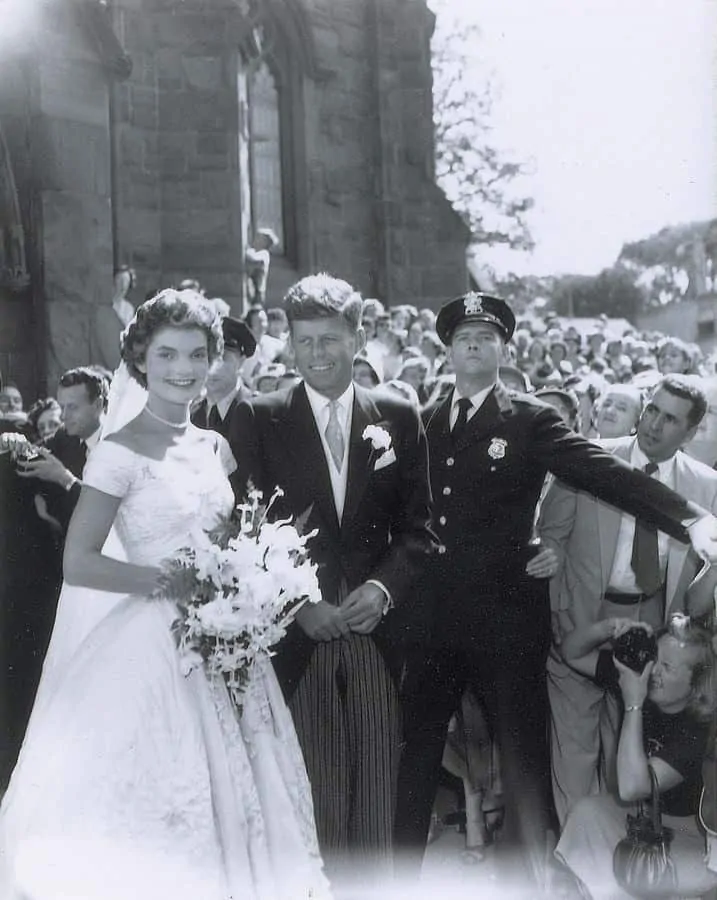
Morning Wear
JFK wasn’t an overly formal person and considering his youthfulness, it is easy to understand why he chose to wear formal morning dress rarely. Nevertheless, on his wedding day and at his inauguration he wore a proper morning coat ensemble. Peaked lapel, one button morning coat with the correct length, single breasted morning vest, white turndown collar shirt, pocket square, cuffless cashmere striped trousers and black oxfords. The only thing that was not so stylish was his wedding boutonniere, which was pinned on his lapel rather than being pushed through the buttonhole.
Even though we wore a top hat briefly on the day of his inauguration, he refused to wear it for the majority of the day, and no president after him has ever worn a top hat during that ceremony again.
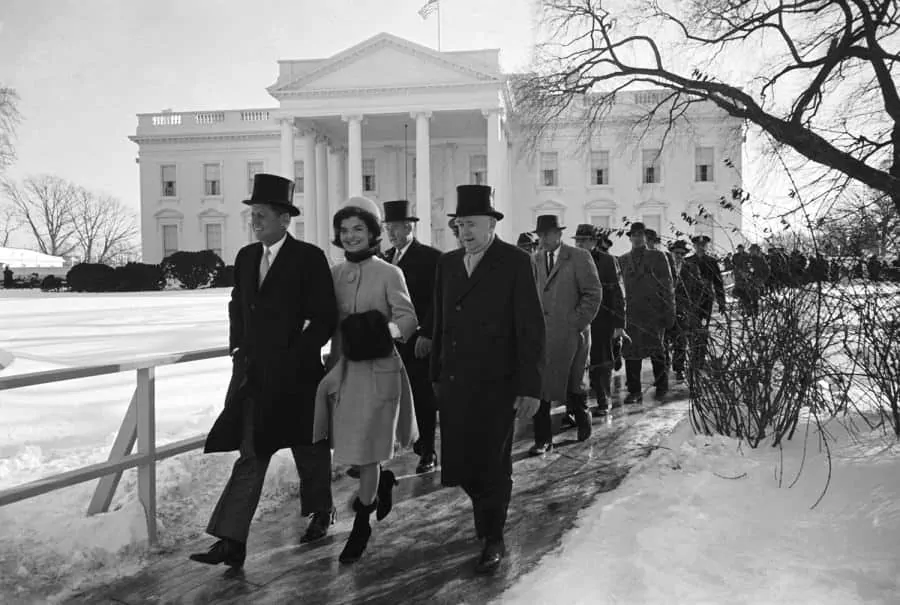
Evening Wear
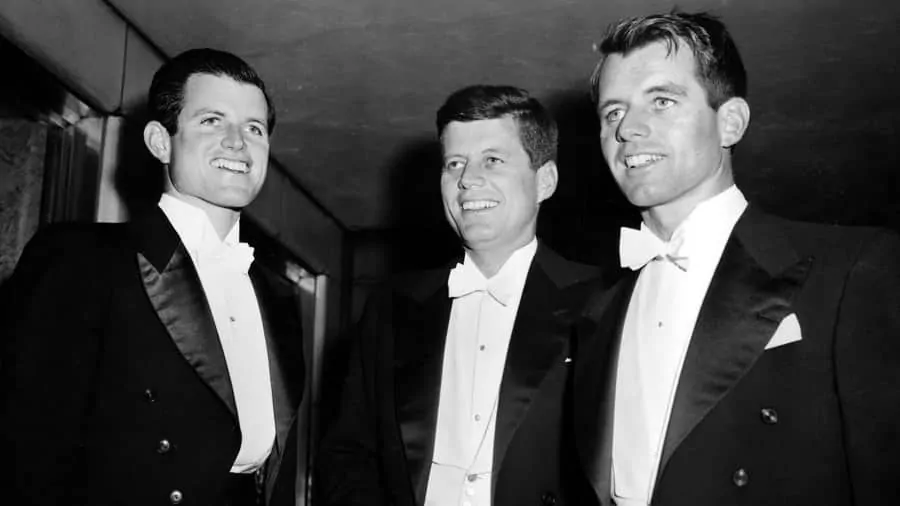
Kennedy did wear proper black tie and white tie when the occasion demanded it, but in a much more natural way than more recent presidents like Obama or George Bush did. He seemed confident and well dressed, whereas Obama or Bush looked like wearing a costume that made them visibly uncomfortable.
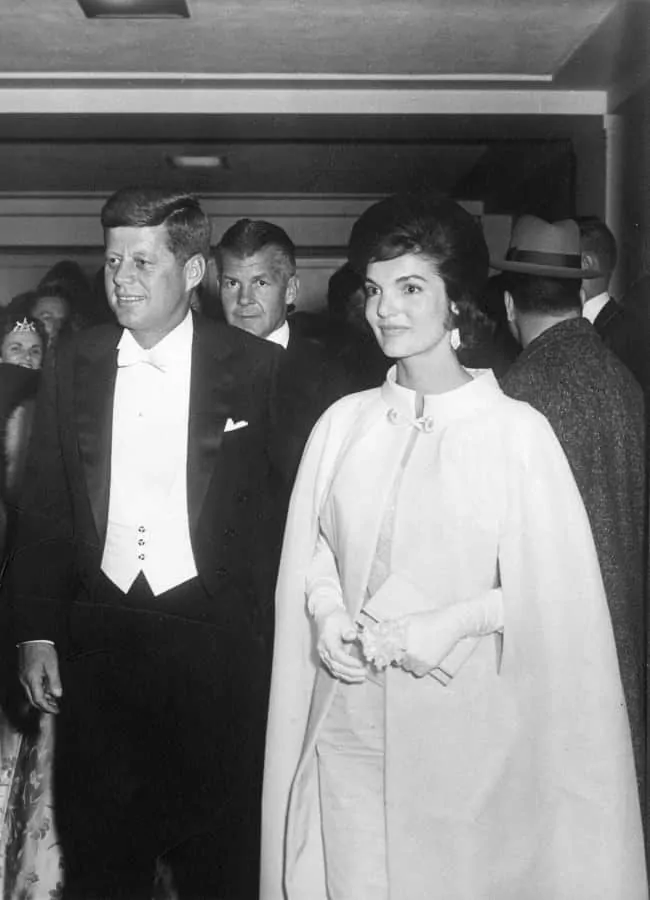
White Tie
If you take a close look at some of JFK’s white tie pictures, you can see that even the details were spot on. First of all, it had a good fit, the shirt had one center stud and a wing collar as well as single starched cuffs. From the pictures, it is hard to tell whether he wore a detachable collar or not – it seems to me like he didn’t but even so, it looked proper. The vest had the right U cut with removable buttons and it did not peek out underneath the tailcoat. Sometimes he would wear opera pumps, at other times he went with black, polished leather oxford shoes.
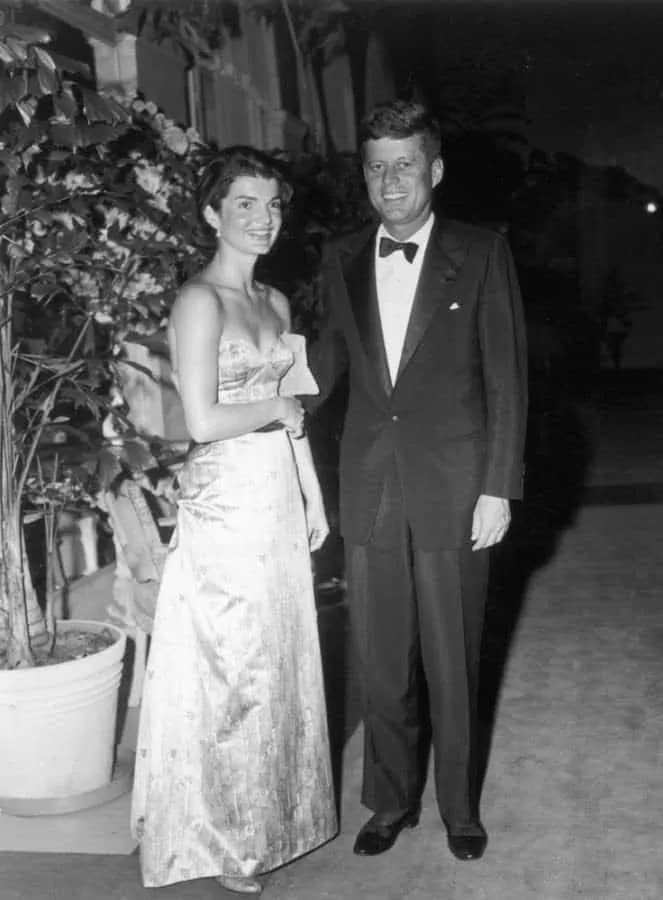
Black Tie
Kennedy often wore his classic single breasted one button peak lapel tuxedo with jetted pockets, and a simple self tie silk satin butterfly bow tie. Sometimes he wore it with a boutonniere and white linen pocket square, sometimes just with the square; he always looked well put together. Instead of wearing a black vest, he was a proponent of the cummerbund, and he would wear it with either black leather oxfords or patent leather opera pumps.
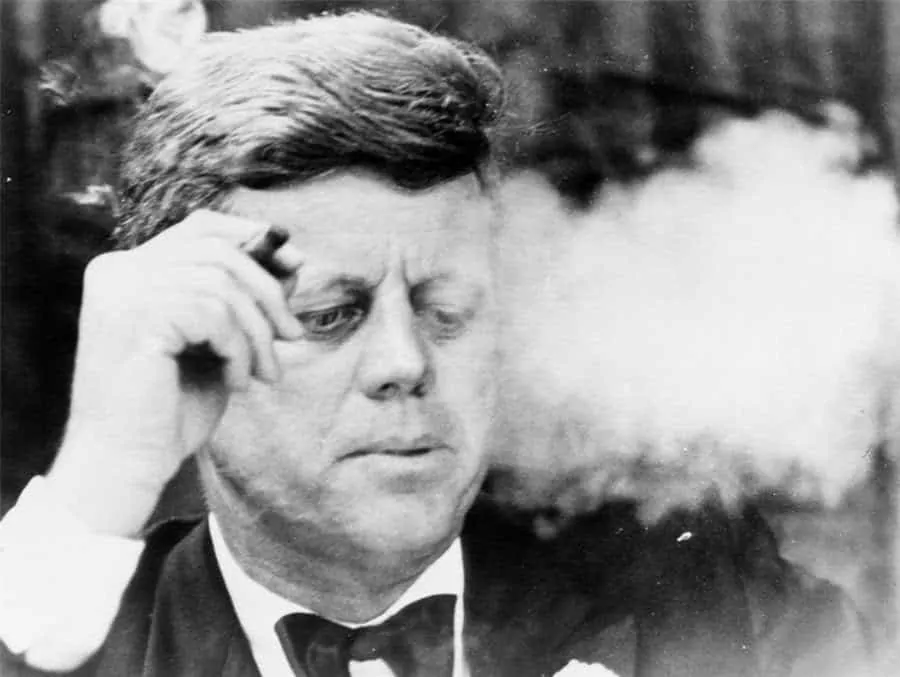
Presidential Affairs
Most people look to Tylenol or Aspirin to relieve a headache, but not JFK. He was a well known for his sex drive, often quoted saying “If I don’t have sex every day, I get a headache”. He said this on many occasions to a variety of people within his sphere of influence. He enjoyed sex, although what man doesn’t. The one differential however is that JFK wasn’t phased by the thoughts of adultery. He wasn’t opposed to seeking the affection of women outside his marriage and his wife’s staff and friends weren’t above being cast into his net.
Doubtless many of his affairs were kept secret, behind closed doors at the White House. However, JFK wasn’t just any man, he was one of the most memorable presidents, a world leader, but he clearly had his weaknesses.
One of his most notable conquests was that of actress Marlene Dietrich, a friend and many say lover of his father’s. According to sources close to JFK and Dietrich, the then sixty year old actress accepted an invitation to the White House in the fall of 1963 prior to a one-woman show she was to perform later that same evening. According to the Dietrich, JFK made a pass at her in the bedroom closest to the West Sitting Room of the White House. Despite only having thirty minutes until she was set to take the stage, she accepted and disappeared with the President for approximately twenty minutes, after which, he immediately fell asleep. Allegedly, Dietrich had to wake the President because she had no idea how to get out of the house.
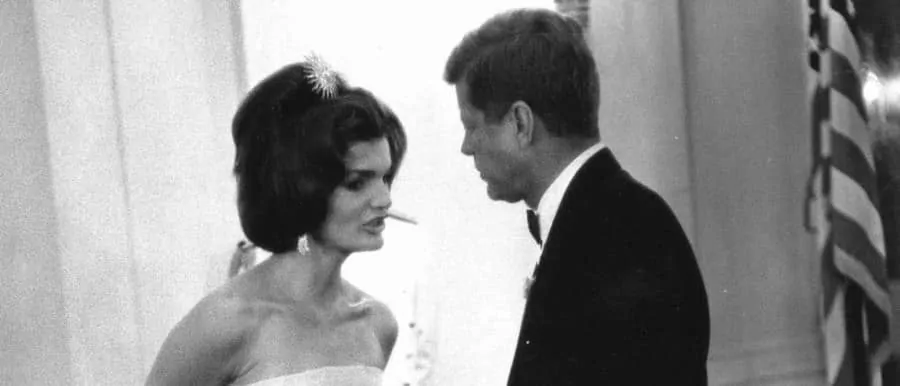
According to historians, JFK wasn’t a picky man and didn’t just enjoy the company of models and actresses. In fact, he often looked for women on his home turf at the White House with whom he could engage in a sordid affair with.
One such woman was a 19 year old White House intern named Mimi Alford who was assigned to the press office. According to Alford, she met him after first starting her internship while relaxing in the White House pool. Allegedly, JFK swam up to her and introduced himself, before inviting her back to the residence for drinks after work. She obliged and he offered her a private tour of the home before seducing her in what he called “Mrs. Kennedy’s room”. Despite JFK being well practiced, it was in fact Alford’s first time having sex. For eighteen months, they continued the affair, and according to Alford’s memoir, it was so erotic that JFK even went so far as to include other aides by daring her to perform oral sex on at least one other, in the somewhat public White House pool.
Pamela Turnure was another staffer JFK was known to sleep with. However, Turnure was a member of Mrs. Kennedy’s staff, not the Presidents. Known for looking strikingly similar to Jackie, Turnure began her affair with the President when she was 21 which lasted from 1961 to 1963. It is rumored that during that time, on nights when Jackie was traveling, Turnure would spend the night with JFK in the couple’s private quarters.
The trysts with staffers didn’t end there. Two secretaries by the names of Priscilla Wear and Jill Cowen, known by their security codes “Fiddle and Faddle” were well known on the grounds for their extracurricular activities with the President. According to a former Secret Service agent, neither of them were very good at their jobs and both were well known for leaving work throughout the day to go skinny dipping with the President in the swimming pool. Accordingly to Caitlin Flanagan, a reporter with the Atlantic, Jackie was quite aware of this particular affair, once commenting in French to a reporter from Paris that “This is the girl who supposedly is sleeping with my husband.” According to documents, the two secretaries often accompanied JFK on official trips to various locations around the world and would often take breaks during the work day to have rounds of sex with the President.
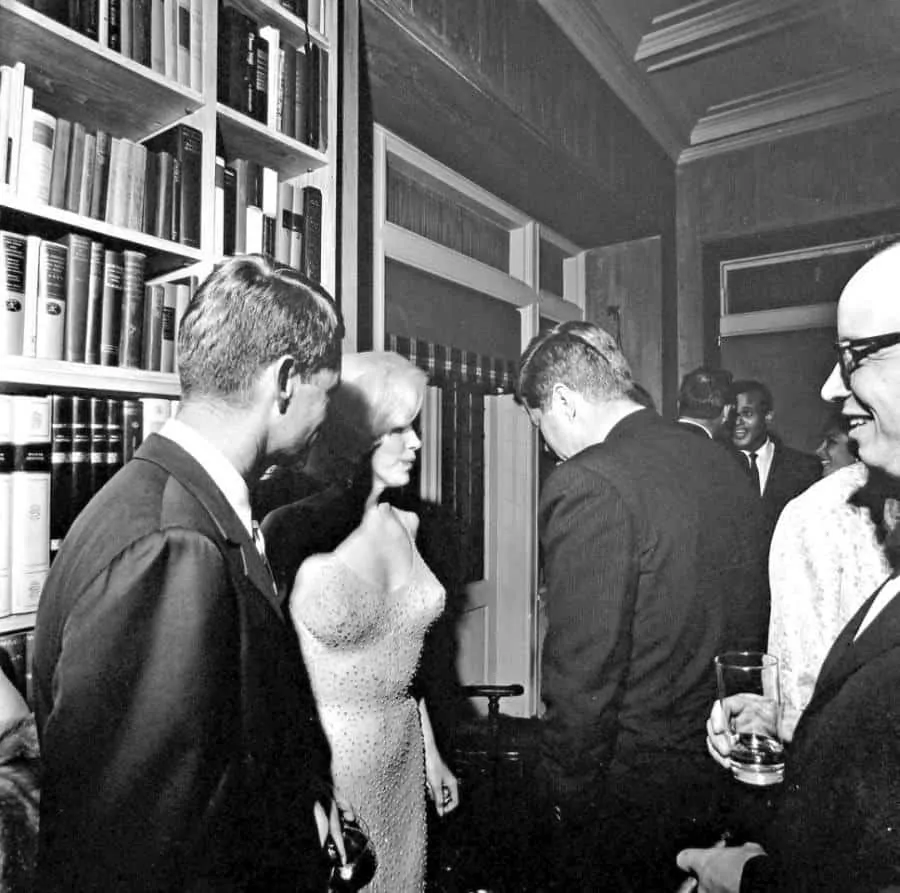
Of course, JFK wasn’t exclusive to just sleeping with his staff. He was well known for engaging in affairs with socialites, strippers, prostitutes and some of the world’s most well known celebrities which included Angie Dickinson, Mary Pinchot Meyer, and of course, Marilyn Monroe.
When Marilyn Monroe met JFK in the winter of 1962, his first remark to her was “Finally! You’re here.” Immediately, after which he asked for her phone number. The next month, she accompanied the President to Palm Springs where they spent a weekend at Bing Crosby’s house. For whatever reason, the affair appeared to only last the one weekend, after which JFK left in search of other women. However, according to multiple sources, Monroe wasn’t finished and viewed herself as a replacement of Jackie’s. According to many people who knew both of them, she felt she deserved to be the first lady and was willing to do whatever it took to assume the role. At one point, she even went so far as to call Jackie Kennedy on the phone and tell her about the affair. Jackie, who already knew about her husband’s infidelity, responded with “Marilyn, you’ll marry Jack, that’s great . . . and you’ll move into the White House and you’ll assume the responsibilities of first lady, and I’ll move out and you’ll have all the problems.”
The list of women goes on and many experts believe that JFK viewed all the women he met as potential suitors. He had many problems in his life, but one of the most well known was his infidelity and the distrust that it placed with his wife and his children.
The Assassination of JFK
During a trip to Dallas, Texas in an effort to smooth relations between liberals Ralph Yarborough, Don Yarborough and John Connally, during the motorcade parade, Kennedy was shot three times at 12:30 pm CST on November 22, 1963.
Riding in an open convertible beside his wife, the first shot hit him in the throat, the second in the upper back, with the fatal shot hitting him in the head. Kennedy was rushed to Parkland Hospital but pronounced dead at 1:00 pm at the young age of just 46.
On November 25, 1963, a Requiem Mass was held for the late President at the Cathedral of St. Matthew the Apostle. Following a Presidential procession, his body was buried at Arlington National Cemetery. The honor guard was the 37th Cadet Class of the Irish Army. JFK was so impressed by the cadets during his last official visit to Ireland, that his wife, Jackie Kennedy, personally requested they serve as the honor guard at his funeral.
Disclaimer: The video contains disturbing content.
The immediate investigation following his death revealed that the shots were supposedly fired from the Texas School Book Depository where an employee by the name of Lee Harvey Oswald was subsequently arrested for the murder of a local police officer. Despite his denial of shooting anyone, and claim that he was nothing more than a patsy, it was later determined that he was the sole assassin who had also killed the President. Just two days later, before going on trial, Oswald was killed while being escorted by police by a man named Jack Ruby. Ruby was arrested and convicted for the murder of Oswald but managed to successfully appeal his conviction and death sentence before becoming ill and dying of cancer on January 3, 1967.
To this very day the assassination of President Kennedy is a hotbed of discussion and one that many believe is a conspiracy. A large number of these theorists believe Oswald was innocent and that there was a far more sinister plot at work.
Regardless, a great man was killed that day and a nation shaken to its very core. Men and women around the world still remember the very place they stood when the news rang through that the President had been assassinated. My father, a Canadian, has a clear recollection of being in school that day when it was announced over the loud speaker. Just as our younger generations will forever remember their place in the world when September 11th occurred, Kennedy’s assassination will forever remain a blood stained mark in the history books that should, in most opinions, never have occurred.
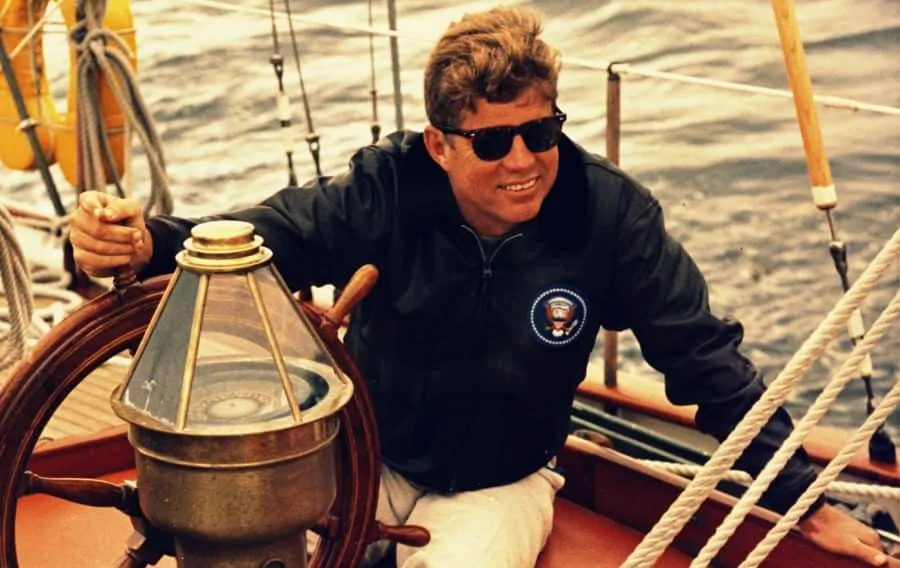
Dear Good Readers ,
This is a magnificent article on the ways of John Fitzgerald Kennedy .
Apart from the unquestionable style this man had is also his lovely manners , grace and charm, poise and commitment to the equality of all mankind
I was a boy of just 11 years when President Kennedy suffered one of the most despicable acts of violence ever perpetrated and the effect upon me growing up in Sydney Australia was profound .. In 1990 I visited Dallas Texas to pay my own personal tribute to him .
To all younger men of today please make a study of him , for all his goodness and forgivable short comings .
What a guy !!!
Thanks for sharing Mark!
I’m always amused by the fascination with JFK’s sexual activities. If you think about it, most strong leaders have strong sex drive too. Hmmm… maybe the two go together somehow? I’m sure many people are 100% faithful to their wives, but there are many couples who have ‘an understanding’ and it’s not always the man alone who is satisfying the drive. If it destroys lives, as it did Ms Monroe’s, there’s the tragedy. Otherwise I suspect it’s a lot of noise from people who are envious. Truly monogamous couples, I salute you! Open ones can be just as legitimate.
Of course it is always up to couples how they want to live their relationship, and what they want to do. However, if you preach water and drink wine yourself, you lose any credibility. Also, if you use your power to kick prostitutes you engaged with out of the country to keep things under the carpet, we can’t really talk of democratic values anymore…
President Kennedy had a classic WASP style all his own.
Much like Cary Grant, no matter what JFK wore whether it be correct or incorrect, he always looked comfortable.
Brooks Brothers was probably ground zero for a lot of his wardrobe but I do know that he was a customer of The Andover Shop in Boston, and Chipp Inc. in New York as well.
I’ve also read he needed help tying his shoes due to the use of a back brace.
I have it on real, real good authority, that JFK’s tailor was a Saville tailor (actually St. George), it was used since his father arrived as Ambassador in the 30’s as well as Robert.
G’day Ed ,
Jack and the other Kennedy lads may well have used Tailors in Saville Row , and why not considering the amount of Americans that were in some part Anglophiles . I see a fair amount of European influence in the cut and block of the jackets and lapels that were tailored . There is some Italian for sure plus using lighter weights like Mohair and Sharkskin .. Anyways he sure looks grand in Tails and Morning Suit .
To my distant eyes one of America’s better dressed Presidents was Ronald Reagan .
I am sure he did not just have one tailor. And it’s Savile Row, not Saville ;).
You are now my designated proof reader and editor .
more feathers to you bow .
JFK always looked elegant and practical ; never a fop.
I was in math class the day JFK was killed….
Hi website owner, do you allow guest posting ? Please let me know, i
am interested .